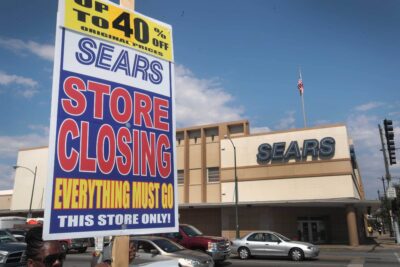
Joan Wong for ProPublica, source images: The Daily Herald, HathiTrust

Share
This story was originally published by ProPublica. ProPublica Illinois is a nonprofit newsroom that investigates abuses of power. Sign up to get weekly updates about our work.
This article was produced in partnership with The Daily Herald, which is a member of the ProPublica Local Reporting Network.
Jobs, thousands of them. That’s the principal reason state and local officials awarded hundreds of millions of dollars in tax breaks over 30 years to keep Sears in Illinois.
Under a 2012 law designed to keep the company from leaving the state, Sears was required to maintain at least 4,250 employees at its sprawling offices in Hoffman Estates and a small satellite office in Chicago. In return, the retail icon received tax breaks worth an estimated $275 million.
But as the company fired hundreds of employees in the years leading up to its 2018 bankruptcy, Sears grew increasingly concerned about maintaining the tax breaks, according to interviews and internal corporate documents.
Company officials began counting baristas, fast-food workers and janitors who worked at Sears headquarters but weren’t employed by the company, records show.
Sears’ counting methods have raised doubts about the legitimacy of millions of dollars in property tax rebates that the company received from Hoffman Estates. A local school district has filed a lawsuit against Sears for $43 million, charging it overcounted the number of employees and collected public money that it should not have received.
The disputed tallies also reveal uneven enforcement by state and local officials, who allowed tax dollars to flow to Sears while ignoring signs — including substantial annual losses, store closures and public notices of mass layoffs — that the fading retail giant was struggling to maintain the required head count.
Politicians who helped draft the tax deals said they were designed to save thousands of well-paying corporate jobs at Sears. Contractors, landscapers and temporary employees deployed to work at Sears-owned properties were never meant to help the company qualify for tax breaks.
“The intention was to include, or count, jobs of Sears employees and staff,” said state Rep. Fred Crespo, a Democrat from Hoffman Estates, who drafted the legislation to extend Sears’ tax breaks and once served on the village board.

Transformco, which now owns Sears, declined to comment.
In court papers, attorneys for Sears Holdings Corp., the remnants of the former retail behemoth, have argued that different agreements with the state and Hoffman Estates included different definitions of jobs. Under a deal worked out between Illinois and local officials to create a special tax district, Sears could include any worker on its premises. Under another deal with the state’s economic development agency for tax credits, it could count only Sears employees.
“Nothing … limits the type of jobs Sears must ‘maintain’ in order to receive its full (tax credit) payments,” wrote David Martin, an attorney for Sears Holdings, in a May 2019 lawsuit motion.
The 2012 law established the 4,250 head count level and created penalties if the company fell below the threshold, but it left open to interpretation who was supposed to monitor compliance.
Mayor William McLeod, who helped promote the 2012 deal, said the village had no responsibility to oversee whether Sears kept its promises.
“I have no mechanism to measure how many people are in those buildings,” McLeod said. “We just follow the law that the legislature passed.”
The Deals
Illinois and Hoffman Estates leaders first crafted an incentive package for Sears in 1989, after the company decided to leave its headquarters at the Sears Tower in Chicago and threatened to move out of the state. Officials created a special taxing district, set to last for 23 years, where Sears could build its headquarters and develop the land into a massive office park.
The property value for purposes of taxation was frozen. As new development boosted the property’s value, the increase in tax revenues was divided. Sears got most of the new revenue, while smaller amounts went to local government agencies.
But the tax deal failed to deliver. After Sears built its new corporate offices on vacant farmland on the village’s western edge, the flood of new jobs and businesses that was expected to follow never materialized. The special tax district did not even generate enough revenue to cover the expenses of its development. Sears wound up paying $125 million for new roads and sewers without receiving tax money in return.
By the mid-2000s, the iconic retail outlet was reeling. Its stock price plummeted, under assault from bad management decisions, competition from low-cost alternatives such as Walmart and the rise of internet retailers such as Amazon. In 2005, Kmart bought Sears and took over its headquarters in Hoffman Estates.
As the special tax district neared the end of its life in 2012, Sears officials threatened a second time to move out of Illinois unless state legislators extended the deal for 15 more years. Sears wanted more time in order for the company to recoup the $125 million spent on development projects.
Sears lobbyists promised dire results should the company depart. The state would lose $3.2 billion in economic activity, 17,000 jobs and $130 million in taxes, according to a study commissioned by Sears.
Concerned about the economic consequences, Hoffman Estates and top state officials were in favor of granting Sears the additional time.
But Sears’ request met with resistance from some legislators and local officials in Algonquin-based Community Unit School District 300. Its boundaries overlap the Sears tax district, though children from Hoffman Estates attend schools in a different district.
Parents who were tired of years of budget cutting, overcrowding and below-average per-pupil spending were outraged. They protested at the state Capitol and testified at public hearings against extending the life of the Sears tax district, known as a TIF, or tax increment financing district.
“When the Sears TIF was proposed, it was sold to the community as, ‘This will help District 300 in the future,’” said Kenneth Arndt, District 300’s superintendent from 2001 to 2011. “The community was sold a bill of goods.”
But local officials said few Hoffman Estates kids go to school in District 300. Despite that, the district received $52 million from the growth in property tax revenues that resulted from Sears’ decision to build its headquarters and other projects in the village.
The school district would not have received any of that money otherwise, they said.
“If it was just farmland, they would be making squat from this,” McLeod said.
No Enforcement
State and local politicians approved a new package of benefits for Sears that took effect in June 2012. The special tax district was extended for 15 more years — a lifeline estimated to be worth $125 million in additional tax rebates and exactly the amount Sears needed to cover the costs of building news roads and office parks financed by the company.
The Department of Commerce and Economic Opportunity, the state’s economic development agency, sweetened the deal with an offer of tax credits worth up to $150 million over 10 years to be applied against payroll taxes.
State and local officials obtained one big concession in the new deal. Sears had to make sure that it kept 4,250 workers employed. If the company failed to meet the staffing level, the agreements allowed state and local lawmakers to reclaim the credits.
“The clawbacks were very important,” said Crespo, the state representative. “There’s no way we were going to risk putting the money out there not knowing if we were going to get the returns that we expect to get.”
Sears itself did the counting.
To obtain the state tax credits, Sears filed yearly reports with the economic development agency to show the company had maintained more than the 4,250-employee benchmark.
The economic development agency had the ability to review the count or conduct on-site visits. But when ProPublica and the Daily Herald asked the agency for evidence of its monitoring of Sears since the agreement began, the department provided a single, four-page audit, paid for by Sears and dated May 2015. The audit found that 25 employees randomly selected by Sears were listed on the company’s payrolls. But it also warned that the findings were not “an opinion on compliance.”
There is no other indication the agency tried to determine if Sears was holding up its end of the deal, even as it annually disbursed approximately $15 million in tax credits.
Under the law, agency officials are supposed to issue biennial assessments of the tax credit program’s effectiveness.
However, the state’s auditor general found that the development agency did not issue such reports between 2012 and 2018 on any tax credit deals, including the one for Sears. In fact, the last time the agency released a report on the efficacy of the credits was November 2005, roughly eight years before Sears got its credits.
Officials with the agency declined to comment.
Experts say that Illinois is not alone in its lax oversight of tax-funded development deals.
A 2017 state audit of the Wisconsin Economic Development Corporation, for instance, found that the agency did not independently verify job numbers claimed by the beneficiaries of tax credits. Nor did it penalize companies when it became aware that companies missed targets established in their agreements.
State development agencies have traditionally failed to hold tax credit recipients accountable for promised economic growth or jobs, experts said.
“This is the same problem across states,” said Nathan Jensen, a professor at the University of Texas at Austin who studies economic development. “We don’t see enforcement.”
“Cost Challenges”
Sears’ difficulty in keeping jobs at its headquarters spilled into public view in 2017.
In February, Sears announced the termination of 120 to 130 employees in Hoffman Estates.
The news was hardly surprising. Over the years, the struggling retailer had cut thousands of corporate jobs and closed hundreds of stores. Layoff announcements at Sears’ headquarters had become almost as regular as holiday-weekend sales at its stores.

State officials began to wonder if Sears was keeping its promises. In correspondence with the Department of Commerce and Economic Opportunity, Sears assured state officials that the company was fully compliant, with 4,410 employees.
Behind the scenes, Sears was engaged in a daily struggle to cut costs throughout its empire. Top officials were distributing “cost challenges” urging managers to find ways to remain solvent. That meant, among other bad options, downsizing.
But the more people the company shed at its headquarters, the greater the risk became that it would fall below the job requirements to keep its state and local incentives.
Sears staffers tracked its head count as closely as they did sales of Kenmore appliances at its stores, according to corporate records divulged in court filings.
Sears staffers forecast that the company would lose 130 to 140 people at its headquarters complex — including Sears employees and non-Sears employees — every month in the coming year, the records show. Based on such attrition, the staffers predicted the company would fall below the 4,250 threshold by February 2018.
“If we fall below the threshold, the (tax district benefit) is suspended until it’s cured,” Amita Agarwal, a Sears employee who tracked the numbers, wrote in an email to Rob Riecker, CFO of Sears Holdings, and other senior executives, which was included in a filing by the school district suing Sears.
Agarwal also warned them of the stakes: Sears could lose nearly $9 million in revenue from the special tax district.
Agarwal estimated that the company’s head count would be only 3,240 people by the end of 2018, including all of the tenants and contractors.
“In order for us to secure this credit, we need to find more tenants and rent out some of the underutilized space at the campus,” Agarwal advised.
Agarwal declined to comment. Transformco declined to make Riecker available for an interview.
In June 2017, Sears eliminated 375 more corporate jobs. Now, there was little question. Sears was at least 215 employees short of its minimum head count for eligibility for the state credits — a fact acknowledged by Howard Riefs, a Sears spokesman at the time.
That month, state officials decided to suspend Sears’ tax credits, refusing to provide nearly $15 million in payroll tax rebates that the company believed it was owed. Sears fought back, threatening to file a lawsuit. The two sides settled in December 2017, splitting the difference. Sears got tax credits for 2016 but agreed not to ask for any more for 2017. Sears is no longer receiving the credits.
Meanwhile, Sears told Hoffman Estates a different story.
On Nov. 27, 2017 — more than five months after Sears had already acknowledged that it no longer had 4,250 corporate employees in both Hoffman Estates and Chicago, a Sears executive wrote to village officials.
“As of the date of this letter, over 4,250 jobs exist at the Sears Holdings’ campus in Hoffman Estates,” wrote Jonathan Bredemeier, the former director of real estate at Sears. “At no time in 2017 did the number of jobs dip below the requisite 4,250 jobs.”
Bredemeier did not return calls for comment.
Sears increased its head count for its taxing district by counting hundreds of employees who didn’t work for Sears. They worked for other companies that rented space in Sears’ gigantic headquarters building, including small businesses such as Evergreen Cleaners and fast-food outlets such as Sbarro Pizza and Panda Express. Sears also counted hundreds of other outside contractors, including janitorial, maintenance, landscaping and cafeteria workers, who serviced the Sears complex.
Many of these workers were not full-time employees, as required by the 2012 agreement. Others were only temporary, project-based workers — not the corporate-level jobs that Sears had promised to keep in return for the public money.
The difference between the two counts was significant, both in raw numbers and in dollars.
In 2017, Sears told the state commerce department that it maintained a total of 3,339 employees at its Hoffman Estates headquarters. That same year, it told Hoffman Estates that it had 4,435 workers at its headquarters — a difference of almost 1,100 people.
The higher count for the taxing district allowed Sears to make a claim for $7 million in property tax reimbursements in 2017 — money that would have otherwise flowed to local agencies, including District 300.
The Lawsuit
The validity of Sears’ counts — particularly, whether Sears was allowed to include non-Sears employees — will be determined by the courts.
In 2018, just days before Sears declared bankruptcy, District 300 filed a lawsuit in Cook County Circuit Court alleging that Sears inflated its head count for years, depriving local schools of more than $43 million in property taxes. School officials arrived at the figure by calculating the district’s share of tax revenues that, it claims, had been wrongly distributed to Sears since 2013, plus interest.

In its legal filings, Sears contends that it has fully complied with the tax district’s 4,250-employee requirement. Sears interprets the guarantee to mean that it only had to “maintain 4,250 jobs” and not necessarily “employees” inside the tax district. The special district law, Sears argues, neither specifies nor limits the types of jobs that the company must maintain.
District 300 says that interpretation “turns the statute on its head.” Only Sears employees should count, the district says.
Since the school district filed its lawsuit in October 2018, Sears has stretched its interpretation of jobs requirement even further. The company now claims that it need only maintain 4,250 jobs within the special tax district as a whole and that it is not limited to counting just those who work inside its corporate headquarters.
In other words, if it wanted to, Sears could count the housekeeping staff at the Marriott Hotel, or the concession workers at the Sears Centre, or the firearms sales associates at Cabela’s — all businesses inside the special tax district — and still remain eligible for tax breaks.
Village officials said they had no authority to monitor Sears. Under the tax agreement, Hoffman Estates receives $5 million per year from the taxing district — money that would no longer be guaranteed if it were suddenly shut down because Sears failed to meet the job requirement.
Arthur Janura Jr., Hoffman Estates’ village attorney, said the village saw itself as a middleman. It simply collected tax revenues and then distributed them according to the 2012 law — no matter how many actual employees Sears had in place.
“If [Sears] said they didn’t have enough jobs there,” Janura said, “the village is still required to send them their check.”
David Bernstein is an independent journalist in Chicago. He is currently working on a book on the shooting of Laquan McDonald for PublicAffairs Books. Previously, he was the features editor at Chicago magazine, where he was twice a finalist for a National Magazine Award. Email him at dmberny@gmail.com.

